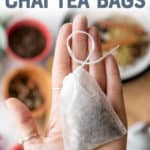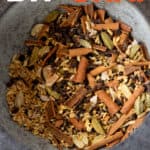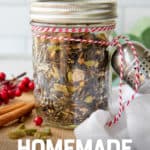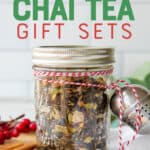There are few things in the world that I love more than a perfectly spicy, slightly sweet, super creamy chai tea latte! I first discovered chai in college when a friend recommended I try a “dirty chai” from the local coffee shop (which is a regular chai latte, but caffeinated to the max with one or more shots of espresso). Dirty Chais got me through many a finals week!
Since then, I have a lot less caffeine in my life (like, none), but chai tea lattes have stayed steady! I’ve made my own decaf chai tea at home for years, and it’s easy, affordable, and super flavorful. It also happens to make an incredibly thoughtful holiday gift for the tea lover in your life!
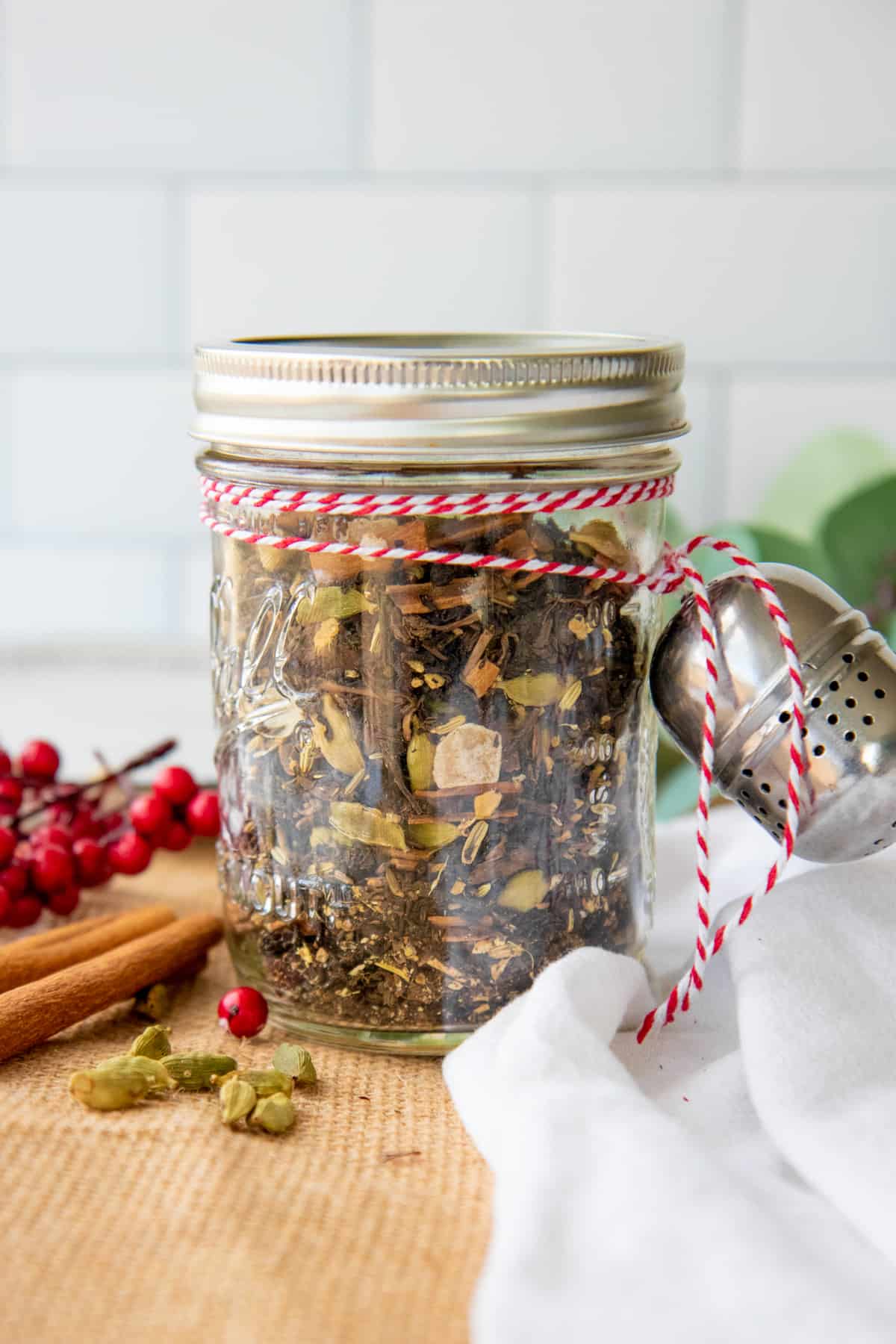
First of all, let’s get this out of the way: yes, when you say “chai tea,” it technically translates to “tea tea” because chai means “tea” in Hindi. What we’re talking about here (and what we in the West associate with “chai”) is technically Indian masala chai—or black tea with spices.
People in India and surrounding countries have been drinking chai as a common household beverage for centuries! It’s only in the past 10-15 years that it’s become popular here in the West. Like many traditional foods (like Dublin Coddle or Herbal Chicken Soup), the exact recipe varies from family to family and region to region. Here is a great article that talks about how there is no such thing as an “authentic chai” because it varies so greatly depending on where you are! I’ve nailed down the chai flavors that I like the best here, but feel free to experiment and have some fun perfecting your chai.
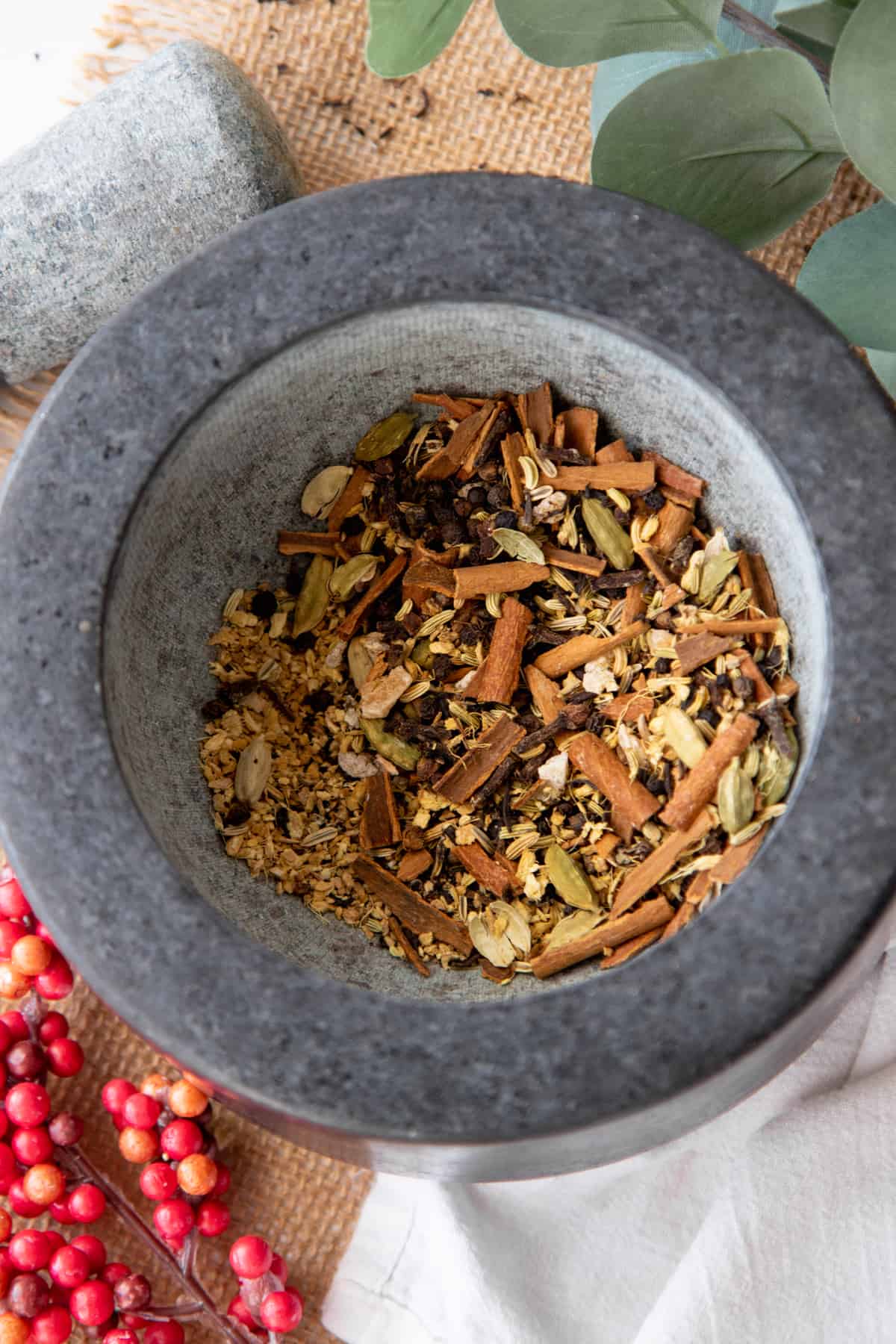
What spices and ingredients make up chai tea?
Like I said, what is included in chai varies from person to person and region to region, but there are some constants:
- Black tea: A bold, strong black tea is the base of almost all chai recipes. In fact, the reason Indian masala chai even exists is because British colonists pushed their leftover low-grade bitter tea to people in the Indian subcontinent to increase sales on a less-than-desirable product. The spices, milk, and sweetener were added to tamp down the bitterness—and now you need a strong tea to get a good flavor! You can also use decaf here if you’re caffeine sensitive, although admittedly it’s a bit trickier to track down strong-flavored decaf black tea. This is the decaf black tea I use, and this is the caffeinated black tea. Assam, Yunnan, and Ceylon black teas should all be strong enough to hold up to the spices for this chai. PG Tips is a good strong black tea that is available in some American supermarkets in loose leaf form, so that’d work too!
- Cardamom: This spice is really what gives chai its distinctive flavor. If you don’t use the cardamom, your chai won’t taste like a chai. I purchase my whole cardamom pods from the bulk section at my local health food store.
- Ginger: Ginger is another cornerstone flavor to good chai. When I’m making myself chai in my kitchen, I tend to use fresh ginger (prepared the same way I do for fresh ginger tea), but in this loose leaf blend, I recommend using dried cut and sifted ginger. You can use crystalized/candied ginger (which should be available in the spice section or the candy section of your grocery store), but it won’t give as strong of a ginger punch.
- Cinnamon, black pepper, fennel, coriander, cloves, other spices: Here is where you can start to experiment! I like my chai with a lot of cinnamon and black pepper (I like it spicy!) and just a touch of cloves. I also like the earthy flavor of fennel in there. You figure out what works for you!
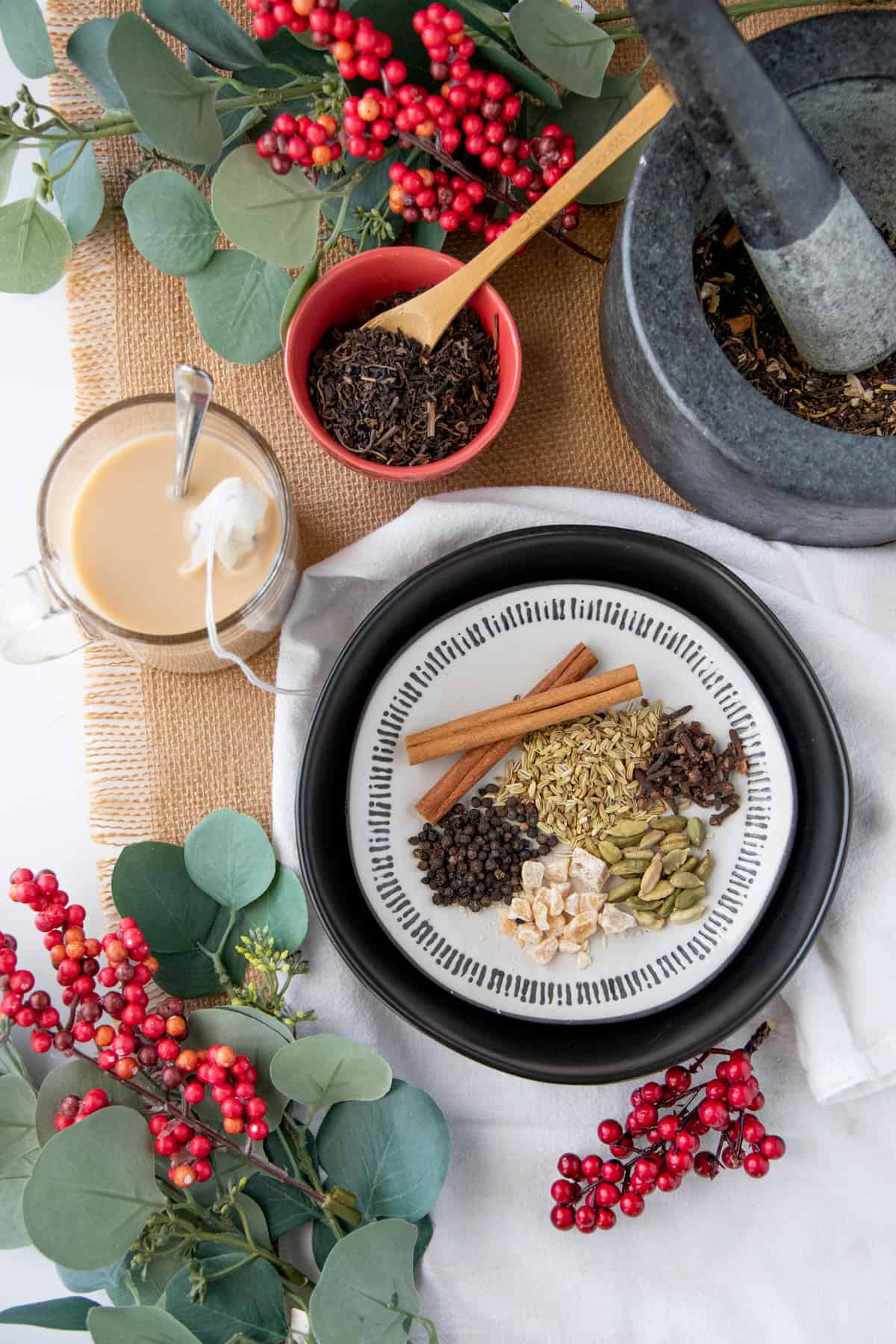
Is chai tea good for you?
Like all things we talk about here on Wholefully, chai can be as nourishing as you want it to be! I recommend sticking with grass-fed organic milk or plant-based milks and unrefined sweeteners (like honey or maple syrup) if you’re looking for a healthy chai tea latte. But remember: just the simple act of taking the time to make yourself a cup of tea and enjoying it is nourishing in and of itself! Regardless of what ingredients you use.
Can you make this homemade chai tea decaf?
You sure can! In fact, I almost exclusively make my chai decaf because I’m super sensitive to caffeine. I use decaf black tea in mine. One caveat: I’ve yet to find a truly strong and bold decaf black tea (suggestions welcome!), so I tend to use a bit more in my mix when using decaf.
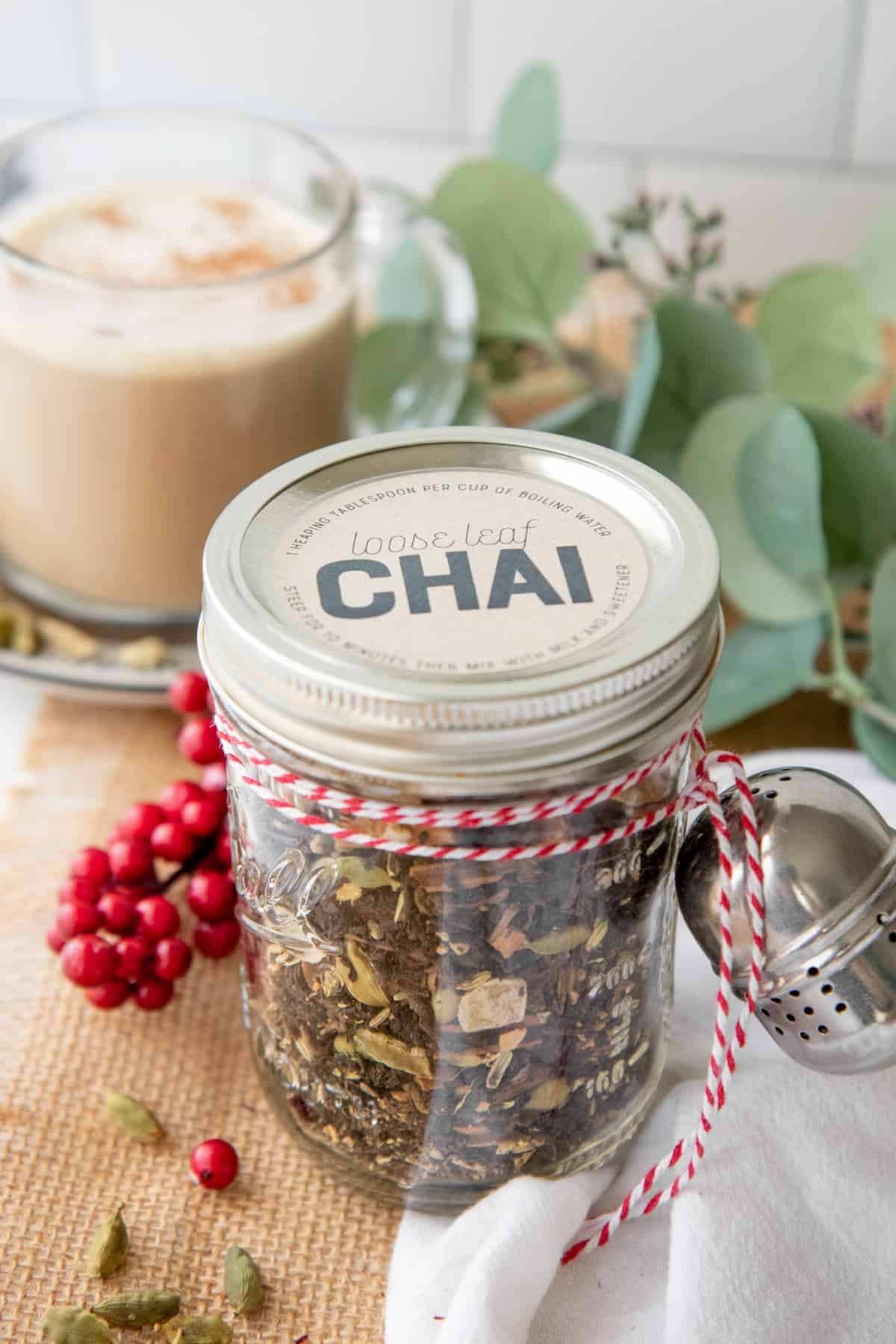
How long should you steep chai tea?
The beauty of chai is that the spices, milk, and sweetener help to mask any bitterness you’d get from oversteeping a black tea—in fact, you almost need a little bit of bitterness to help balance the flavors! I tend to steep my caffeinated chai tea for 7-8 minutes and my decaf chai tea for 10+ minutes.
What’s the best way to drink chai?
Chai is meant to be made into a latte—in fact, saying “chai tea latte” is doubly redundant, because a traditional Indian masala chai always includes milk and sweetener. You could, in theory, drink this homemade chai tea straight, but the silkiness from milk and added sweetener really rounds out the true chai flavor you’re looking for.
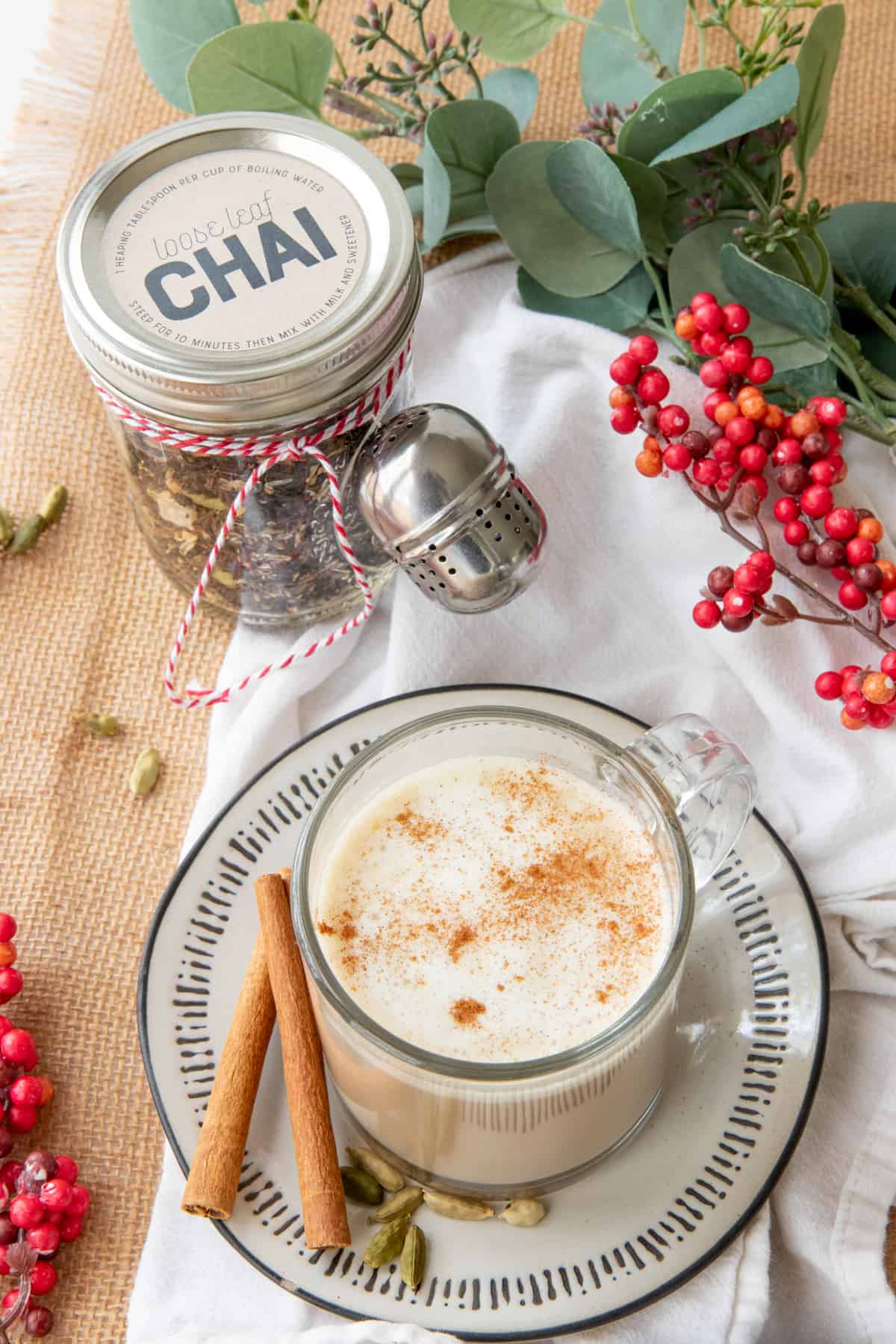
How do you make a chai tea latte?
We’ve included instructions for how to make a perfect homemade chai tea latte in the printable recipe below and on our printable labels below, too. But here’s the gist:
- Steep the chai tea blend in boiling water (7-8 minutes for caffeinated, 10+ for decaf).
- Strain tea or remove the bag.
- Combine with milk and sweetener.
- Go sit somewhere cozy and enjoy a little nourishing self-care moment.
What milk should you use?
As an omnivore, I’m going to suggest that the most glorious, silky, rich chai comes from using raw, organic, grass-fed whole cow’s milk. I buy mine from a local farm, and it really does make just the perfect chai! If you’re dairy-free, you can also make an excellent chai using full-fat coconut milk from the can or a thin cashew cream. Both have the fatty richness you need to get the right chai texture and flavor.
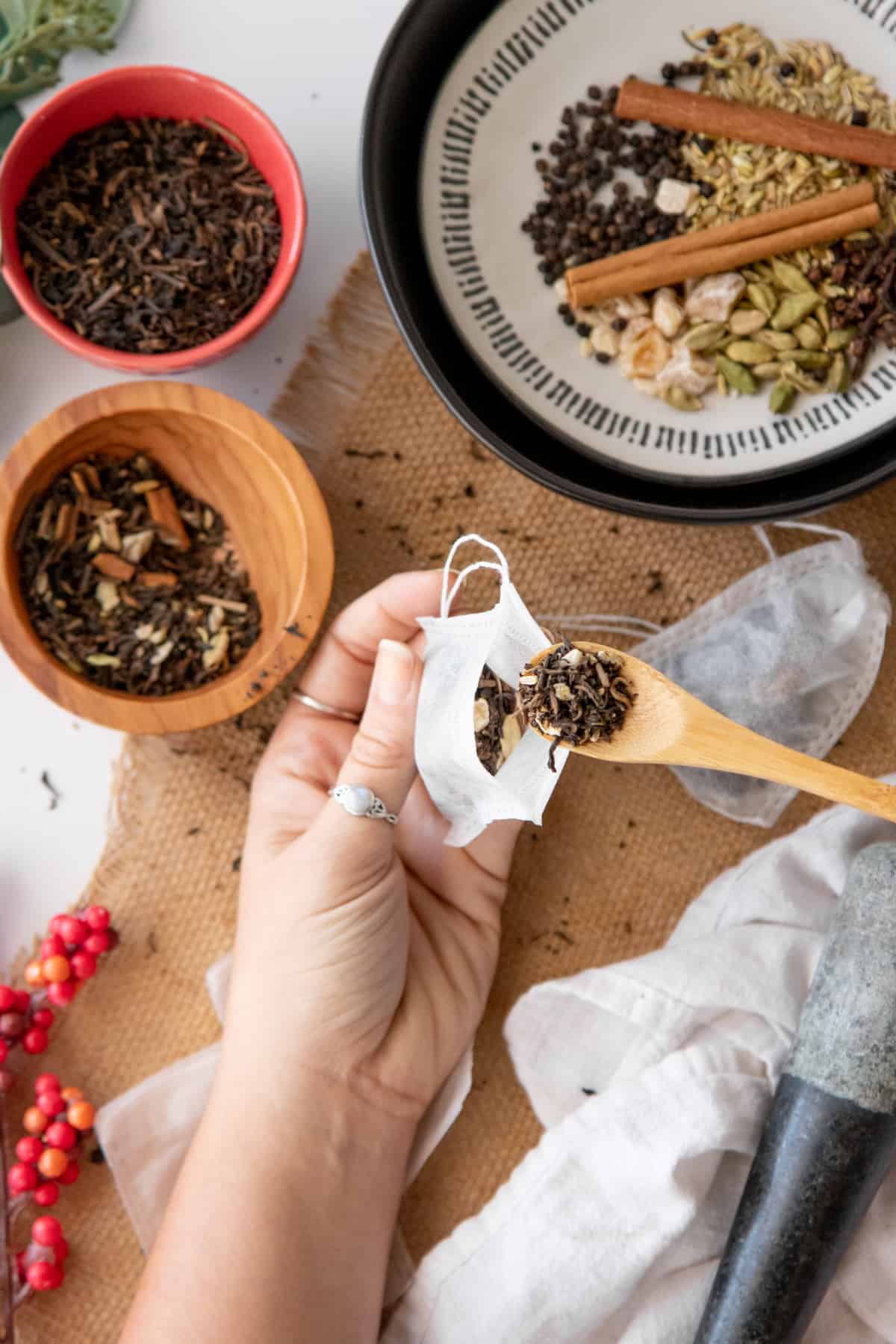
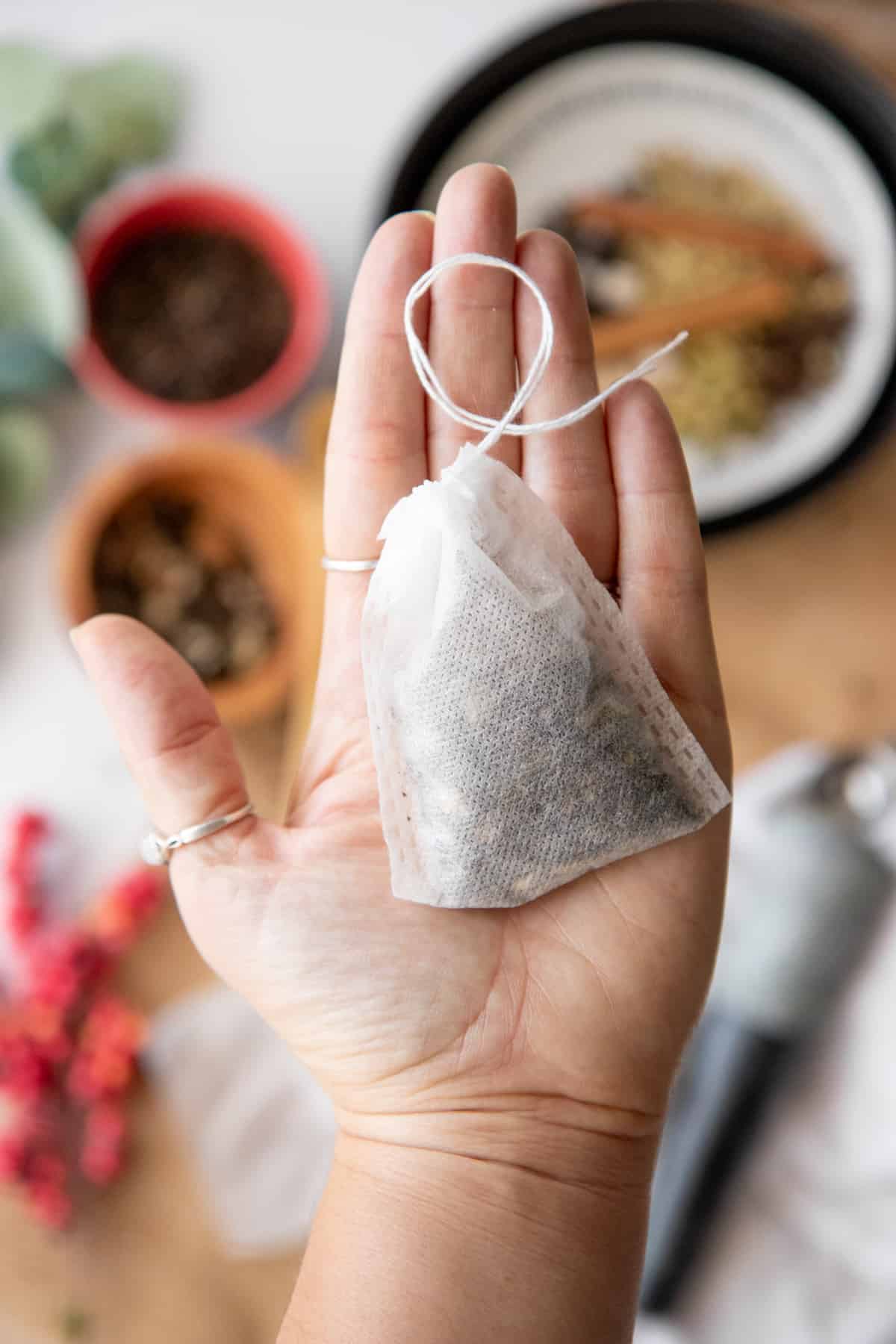
How do you package this tea up for gifting?
Packaging up chai tea (or any loose leaf tea) is a fun, easy, and thoughtful gift for the tea lovers in your life! Here are a few ideas:
- Package the loose leaf tea with a tea ball. This easy handmade tea gift set costs just a couple dollars, and is super thoughtful. Everything is reusable, making this a 100% zero-waste gift!
- Make chai tea bags. Filling tea bags at home is a super fun family project. We ordered 200 of these fillable tea bags, and my kindergartener loves making tea bags! It’s a gift that she can give to her friends and family without much help from me.
For both options, I packaged in wide-mouth pint mason jars, and tied with red baker’s twine. We have printable labels available for both the tea bags and loose leaf tea. They print on 2 1/2” round labels—I used these Avery kraft paper labels. They fit perfectly on the top of a wide-mouth canning jar!
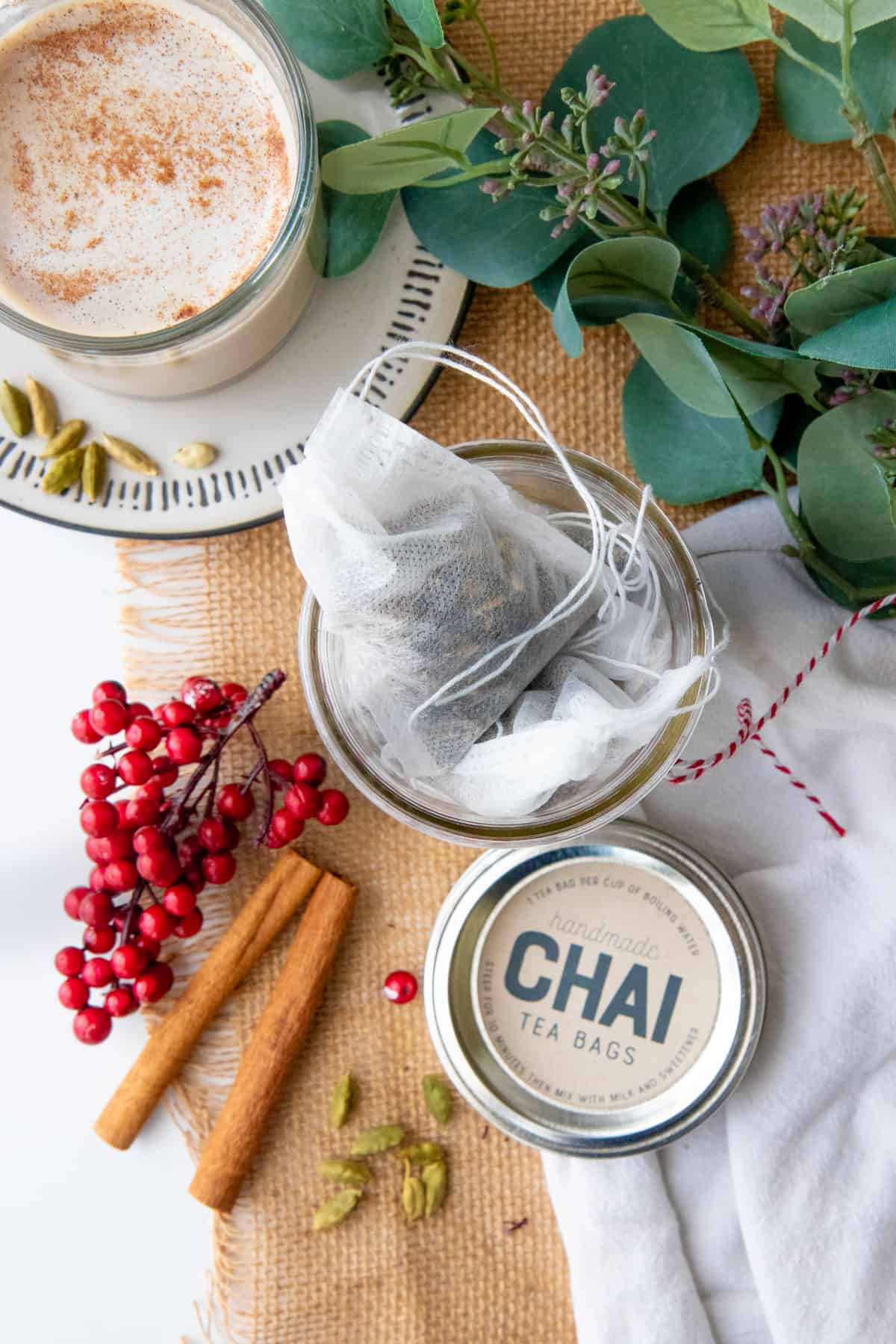
Looking for some other edible gift ideas?
We have tons of great holiday food gift ideas that are easy to make, affordable, and incredibly thoughtful! Here are three you might like:
If you decide to make this chai tea blend for you or for your favorite tea lover, I know you’ll enjoy the flavors of chai in your life. Enjoy!
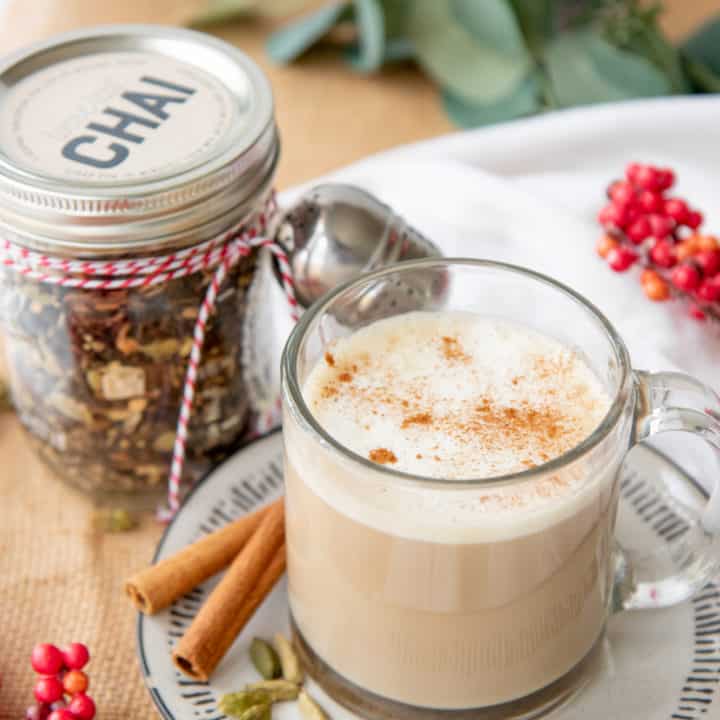
Homemade Chai Tea Blend (Bags or Loose Leaf)
Give the gift of a hot cup of tea with this Homemade Chai Tea! Package it up in an easy (and affordable) gift set for the tea lovers in your life.
Ingredients
- 12 green cardamom pods
- 1 teaspoon whole black peppercorns
- 1 teaspoon fennel seeds
- 1/2 teaspoon whole cloves
- 1 4-inch cinnamon stick
- 2 tablespoons dried cut and sifted ginger (see notes)
- 1/2 cup loose leaf black tea (if decaf black tea desired, see notes)
Instructions
To Make the Chai Tea Blend
- Combine the cardamom pods, peppercorns, fennel seeds, cloves, and cinnamon stick in a mortar and pestle and roughly crush. Alternatively, place spices in a gallon size zip-top bag and crush with a rolling pin.
- Add the spice mixture to a medium skillet over medium-high heat. Toast until the spices are fragrant, about five minutes.
- In a bowl, combine the crushed spices with the dried or crystallized/candied ginger and black tea.
- To fill tea bags: Place 1 1/2 tablespoons of the mixture into a fillable tea bag. Tie closed.
To Make a Chai Tea Latte
- Brew the tea using the ratio of 1 1/2 tablespoons of tea mixture per 8 ounces (1 cup) of boiling water. Brew by either using a tea bag, filling a tea ball, or using a tea pot. Steep for 7-8 minutes for caffeinated tea, and 10+ minutes for decaf tea.
- Add 1/4 cup milk (non-dairy is fine) and natural sweetener (maple syrup, honey, and coconut sugar are all good options) to taste. Top with a sprinkle of ground cinnamon.
Notes
- We have printable labels available for both the tea bags and loose leaf tea. They print on 2 1/2” round labels—I used these Avery kraft paper labels. They fit perfectly on the top of a wide-mouth canning jar! I used wide-mouth pint mason jars to package the tea in these photos.
- Decaf black tea tends to not be as strong as caffeinated tea. Feel free to add a touch more tea to the mixture (2-4 more tablespoons) and/or fill your tea bags and tea ball with more tea (2 full tablespoons).
- In place of the dried cut and sifted ginger, you may use crystalized/candied ginger, roughly chopped.
- Optional other spice additions: red peppercorns (for fun, festive color!), coriander seeds, allspice berries, and star anise. Have fun trying different combos!
Nutrition Information:
Yield: 10 Serving Size: 1Amount Per Serving: Calories: 4Total Fat: 0gSaturated Fat: 0gTrans Fat: 0gUnsaturated Fat: 0gCholesterol: 0mgSodium: 1mgCarbohydrates: 1gFiber: 0gSugar: 0gProtein: 0g
At Wholefully, we believe that good nutrition is about much more than just the numbers on the nutrition facts panel. Please use the above information as only a small part of what helps you decide what foods are nourishing for you.


